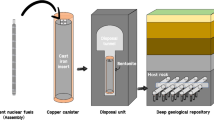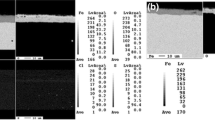Abstract
This paper describes a modeling study for general corrosion of copper which is a candidate material for high-level radioactive waste overpacks. The model is a mixed-potential model combined with diffusive transport of reactants and reaction products. The rest potential and corrosion rate of copper in aerated solution were measured while controlling the thickness of a diffusive solution layer on the copper surface using a rotating-disk electrode. Experimental data were used for validation of the model.
Similar content being viewed by others
References
Power Reactor and Nuclear Fuel Development Corporation, RESEARCH AND DEVELOPMENT ON GEOLOGICAL DISPOSAL OF HIGH-LEVEL RADIOACTIVE WASTE, First Progress Report, PNC TN1410 93-059, (1992), p.4–110.
D.D. Macdonald and F. Urquidi-Macdonald, Corrosion, 46, 380 (1990).
King, M.J. Quinn, C.D. Litke and D.M. LeNeveu, Corros. Sci., 37, 5, 833 (1995).
A. Nishikata, M. Itagaki, T. Tsuru, S. Haruyama and E. Fujii, Boushyoku-gijyutsu, 39, 10 (1990).
A. Nishikata, M. Itagaki, T. Tsuru, S. Haruyama and E. Fujii, Boushyoku-gijyutsu, 39, 17 (1990). 917
F. King, M.J. Quinn and C.D. Litke, A potentiostatic Study of the Reduction of Oxygen on Copper in 1 mol dm −3 NaCl, AECL-1 1061, COG-94-123, (1994).
Y. Marcus, Ion Properties, (Marcel Dekker, Inc., New York, 1997), p. 1 69.
Author information
Authors and Affiliations
Rights and permissions
About this article
Cite this article
Honda, A., Taniguchi, N., Ishikawa, H. et al. A Modeling Study of General Corrosion of Copper Overpack for Geological Isolation of High-Level Radioactive Waste. MRS Online Proceedings Library 556, 911 (1998). https://doi.org/10.1557/PROC-556-911
Published:
DOI: https://doi.org/10.1557/PROC-556-911




